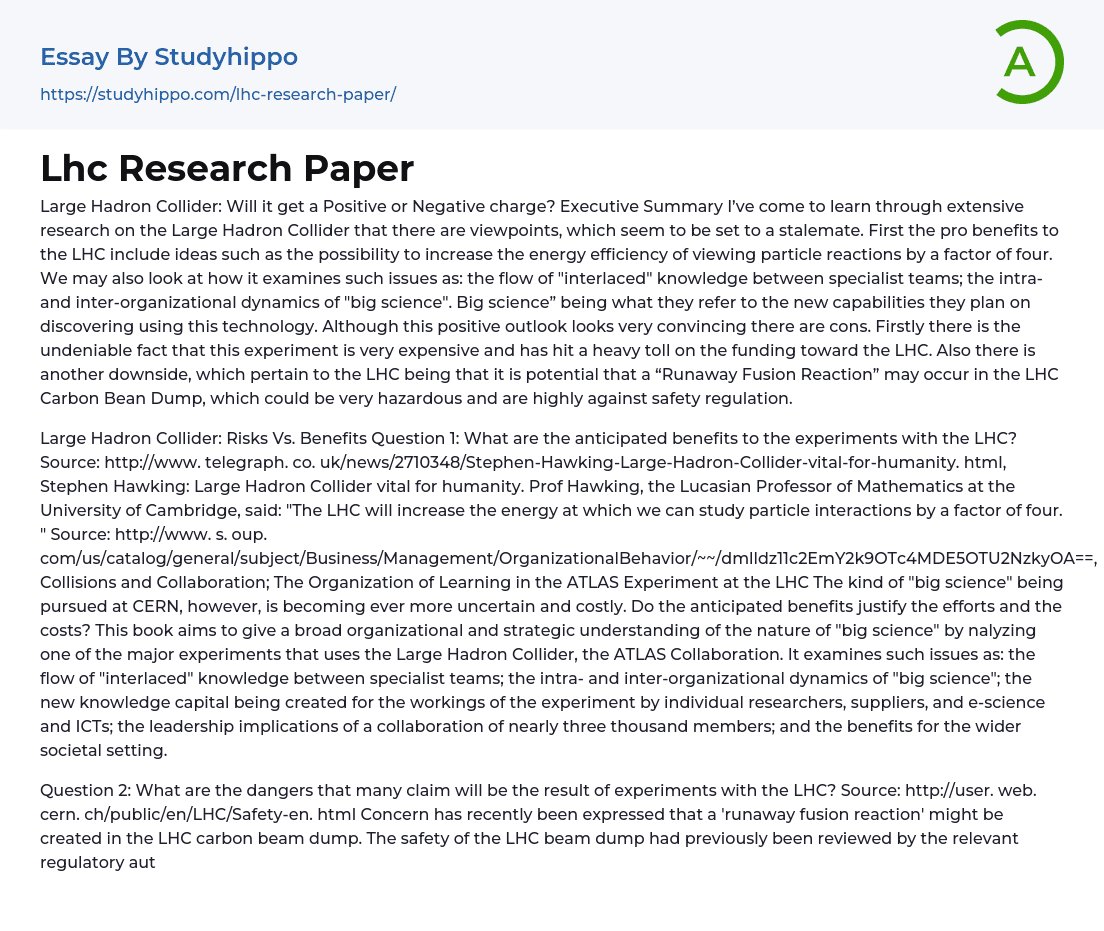Large Hadron Collider: Will it get a Positive or Negative charge? Executive Summary I’ve come to learn through extensive research on the Large Hadron Collider that there are viewpoints, which seem to be set to a stalemate. First the pro benefits to the LHC include ideas such as the possibility to increase the energy efficiency of viewing particle reactions by a factor of four. We may also look at how it examines such issues as: the flow of "interlaced" knowledge between specialist teams; the intra- and inter-organizational dynamics of "big science". Big science” being what they refer to the new capabilities they plan on discovering using this technology. Although this positive outlook looks very convincing there are cons. Firstly there is the undeniable fact that this experiment is very expensive and has hit a heavy toll on the funding toward the LHC. Also there is another downside, which pertain to the LHC being that it is pot
...ential that a “Runaway Fusion Reaction” may occur in the LHC Carbon Bean Dump, which could be very hazardous and are highly against safety regulation.
Large Hadron Collider: Risks Vs. Benefits Question 1: What are the anticipated benefits to the experiments with the LHC? Source: http://www. telegraph. co. uk/news/2710348/Stephen-Hawking-Large-Hadron-Collider-vital-for-humanity. html, Stephen Hawking: Large Hadron Collider vital for humanity. Prof Hawking, the Lucasian Professor of Mathematics at the University of Cambridge, said: "The LHC will increase the energy at which we can study particle interactions by a factor of four. " Source: http://www. s. oup. com/us/catalog/general/subject/Business/Management/OrganizationalBehavior/~~/dmlldz11c2EmY2k9OTc4MDE5OTU2NzkyOA==, Collisions and Collaboration; The Organization of Learning in the ATLAS Experiment at the LHC The kind of "big science" being pursued at CERN, however, i
becoming ever more uncertain and costly. Do the anticipated benefits justify the efforts and the costs? This book aims to give a broad organizational and strategic understanding of the nature of "big science" by nalyzing one of the major experiments that uses the Large Hadron Collider, the ATLAS Collaboration. It examines such issues as: the flow of "interlaced" knowledge between specialist teams; the intra- and inter-organizational dynamics of "big science"; the new knowledge capital being created for the workings of the experiment by individual researchers, suppliers, and e-science and ICTs; the leadership implications of a collaboration of nearly three thousand members; and the benefits for the wider societal setting.
Question 2: What are the dangers that many claim will be the result of experiments with the LHC? Source: http://user. web. cern. ch/public/en/LHC/Safety-en. html Concern has recently been expressed that a 'runaway fusion reaction' might be created in the LHC carbon beam dump. The safety of the LHC beam dump had previously been reviewed by the relevant regulatory authorities of the CERN host states, France and Switzerland. The specific concerns expressed more recently have been addressed in a technical memorandum by Assmann et al.
As they point out, fusion reactions can be maintained only in material compressed by some external pressure, such as that provided by gravity inside a star, a fission explosion in a thermonuclear device, a magnetic field in a Tokamak, or by continuing isotropic laser or particle beams in the case of inertial fusion. In the case of the LHC beam dump, it is struck once by the beam coming from a single direction. There is no countervailing pressure, so the dump material is not
compressed, and no fusion is possible.
Question 3: How do scientists at CERN counter the arguments of the critics? Source: http://www. theinsider. org/news/article. asp? id=2688 In response, particle physicists are developing counter-counterarguments - based on their theoretical work as well as data from astronomical observations and experiments at the Relativistic Heavy-Ion Collider. For instance, the physicists would say that enough of the doomsday particles still should have been captured by neutron stars or cosmic gas clouds to have an impact. No such impact has ever been seen. Therefore, no doomsday.
- Energy essays
- Density essays
- Thermodynamics essays
- Motion essays
- Atom essays
- Sound essays
- Electricity essays
- Nuclear Power essays
- Temperature essays
- Physiology essays
- Light essays
- Force essays
- Heat essays
- Speed essays
- Big Bang Theory essays
- Energy Development essays
- The elements essays
- Voltage essays
- Solar Energy essays
- Nuclear Energy essays
- Alternative Energy essays
- Melting essays
- Nuclear Family essays
- Agriculture essays
- Albert einstein essays
- Animals essays
- Archaeology essays
- Bear essays
- Biology essays
- Birds essays
- Butterfly essays
- Cat essays
- Charles Darwin essays
- Chemistry essays
- Dinosaur essays
- Discovery essays
- Dolphin essays
- Elephant essays
- Eli Whitney essays
- Environmental Science essays
- Evolution essays
- Fish essays
- Genetics essays
- Horse essays
- Human Evolution essays
- Isaac Newton essays
- Journal essays
- Linguistics essays
- Lion essays
- Logic essays




